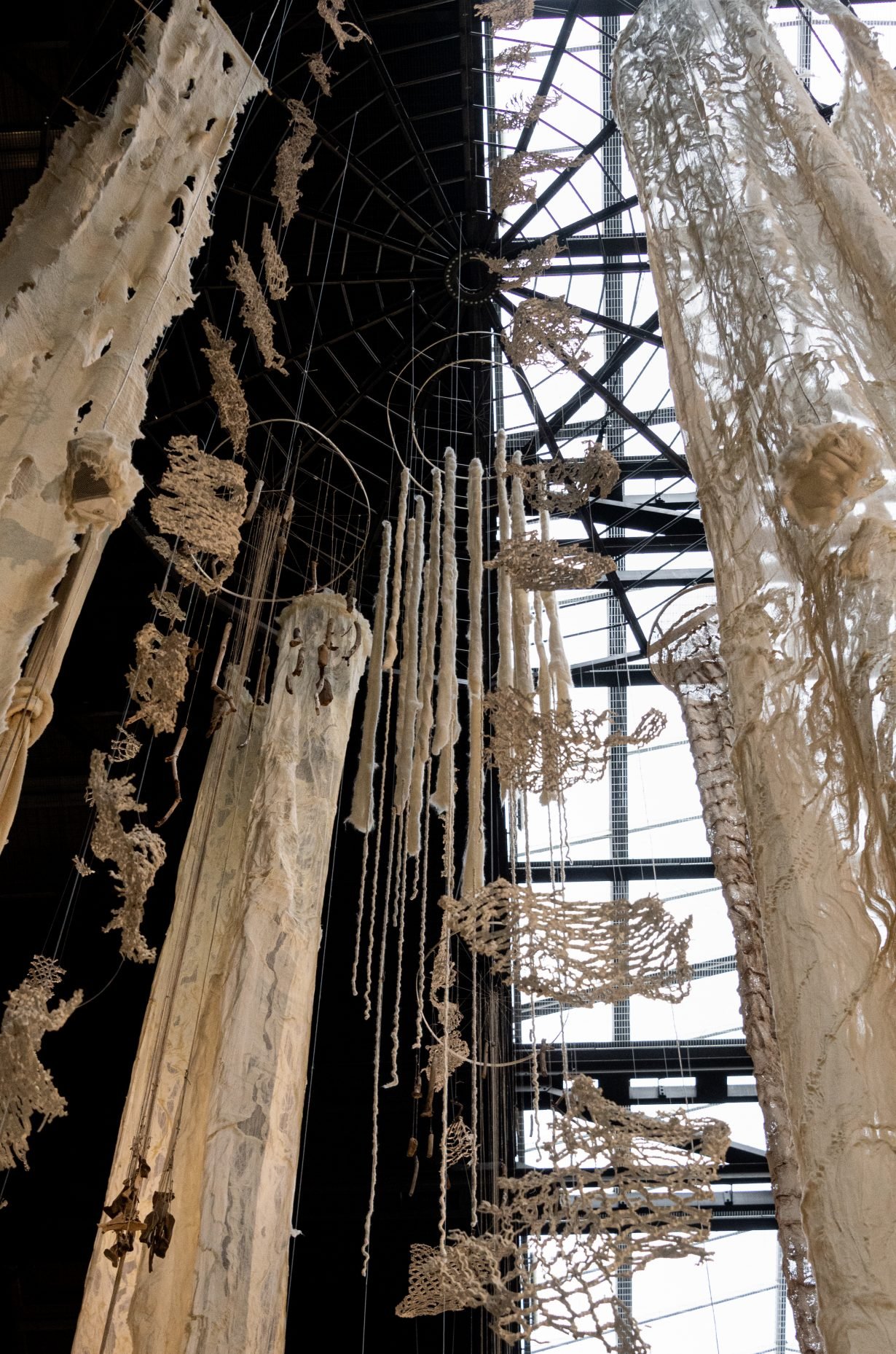Brain Forest Quipu, Cecilia Vicuña, Tate Modern, Turbine Hall
Tate Modern’s Turbine Hall is a notoriously difficult place to fill. Sponsored first by Unilever and since 2015 by Hyundai, there have been some stunning commissions. Ai Weiwei’s Sunflower Seeds made of individually sculpted and painted seed husks. The Danish artist Olafur Eliasson’s Weather Project that had people lying on their backs to experience a huge sun rising out of a mist as if in a South London Nordic winter. Other commissions have been less successful. Rachel Whiteread’s sugar-cube Arctic installation, for instance, that made me think of Iceland packaging and Tino Sehgal’s pretentious choreographed encounters. This year the commission has gone to the Chilean artist, poet and activist Cecilia Vicuña. The simplicity of her Brain Forest Quipu is both moving and strangely beautiful.
Hanging at each end of the Turbine hall are two mobile cascades of knotted rope, mesh and plant fibres that stir softly in the air currents like strips of discarded bark. Interspersed with these are bits of bleached bone and river-worn glass collected from along the banks of the Thames by women from local Latin American communities. This mud larking extends Vicuña’s practice of using found, non-art materials, which she refers to as precarios or precious objects. Like the thick fronds or vines of some great jungle or rain forest, the trailing floor-to-ceiling ribbons are interspersed with natural sounds: water and birdsong, guitars and human voices, including that of the artist. These ghost-like apparitions create a threnody, a torrent of tears to the damage being done to our natural habitat that leaves coral reefs bleached and the bark of trees white with the ash of deliberate forest fires. The sonic element, directed by the Columbian composer Ricardo Galio, weaves the indigenous music of several regions together with a series of deliberate silences. The soft sounds drift through the cathedral vault of the Turbine Hall as you move through the space, creating moments of stillness, haikus of contemplation amongst the busy chatter. There is something shamanic about the work. It’s rather like listening to the lament of the world, to the voices of the rainforests that we’re busy destroying and to the animals and indigenous people who inhabit them.
Traditionally the people of the Andes didn’t write but wove meaning into their textiles and knotted cords to be read, one imagines, almost like braille. Five thousand years ago they created conceptual poems with their quipu or knots that reflected both the measurements of the body and the spirit of the cosmos. These physical song lines were banished by the Spanish conquerors, along with the ceque - sightlines that connected all the communities in the Andes. Like ghostly spirits risen from the dead Vicuña’s forms create eulogies not only to the destruction of our natural world but to the variety of cultures that inhabit it.
Now 74, since the late 1960s she has created poems, paintings and sculptures that explore alternative systems of knowledge, using the wealth of tradition to be found in her indigenous heritage. At 18 her poetry was published in Mexico’s El Corno Emplumando and at 23 she had two exhibitions at the National Museum of Fine Arts in Santiago. From the Escuela de Bellas Artes, Universidad de Chile, she found her way, with the aid of a British scholarship, to the Slade School of Art. After the right wing military coup against Salvador Allende in 1973 she became a founding member of Arts for Democracy whilst living in exile in London and working in a cold studio in Stephney. Now she divides her time between Chile and New York and was, at the 59th Venice Biennale, awarded the Golden Lion for Lifetime Achievement.
Of these heart rending works she has written: ‘the Earth is a brain forest and the quipu embraces all its interconnections.’ Using her poetic sensibilities of silence and sound and her visual acuity as an artist she has created sculptures that seem to sing of depletion and bereavement. At once both fragile and monumental each knot in these quipu installations speaks of blood and grief. Her original quipu sculpture was created in 2006, the year that Michelle Bachelet became the first female president of Chile.
Never didactic, her work lacks self-importance and hubris, gently mirroring all that has been lost and all that might further be lost if we fail to pay attention to this fragile web that is our world. Beautiful, ghostly and melancholy her work shows us that we can choose to be a part of the warp and weft of things, spinners and weavers rather than destroyers. In these sculptures Vicuña not only references the work of indigenous people but also of women with their traditional skills of weaving, knitting and sewing. There is also a nod to the netted and pendulous structures of the late Eva Hesse. Vicuña’s fragile materials echo our ephemeral existence and the vulnerability of our ecosystems. In a world dominated by technology and global greed she gives voice to the beleaguered Earth, to its flora, fauna and people.
Sue Hubbard is a freelance art critic, award-winning poet and novelist. Her third novel Rainsongs is published by Duckworth and her fourth poetry collection Swimming to Albania is available from www.salmonpoetry.com. Her second novel Girls in White on the life of the expressionist painter Paula Modersohn Becker is to be reissued by Pushkin Press to coincide with the Making of Modernism at the RA this autumn and they will publish her fourth novel, Flatlands, next year. Her poems on the life of Gwen John, God’s Little Artist from Seren Books will be published in 2023.
